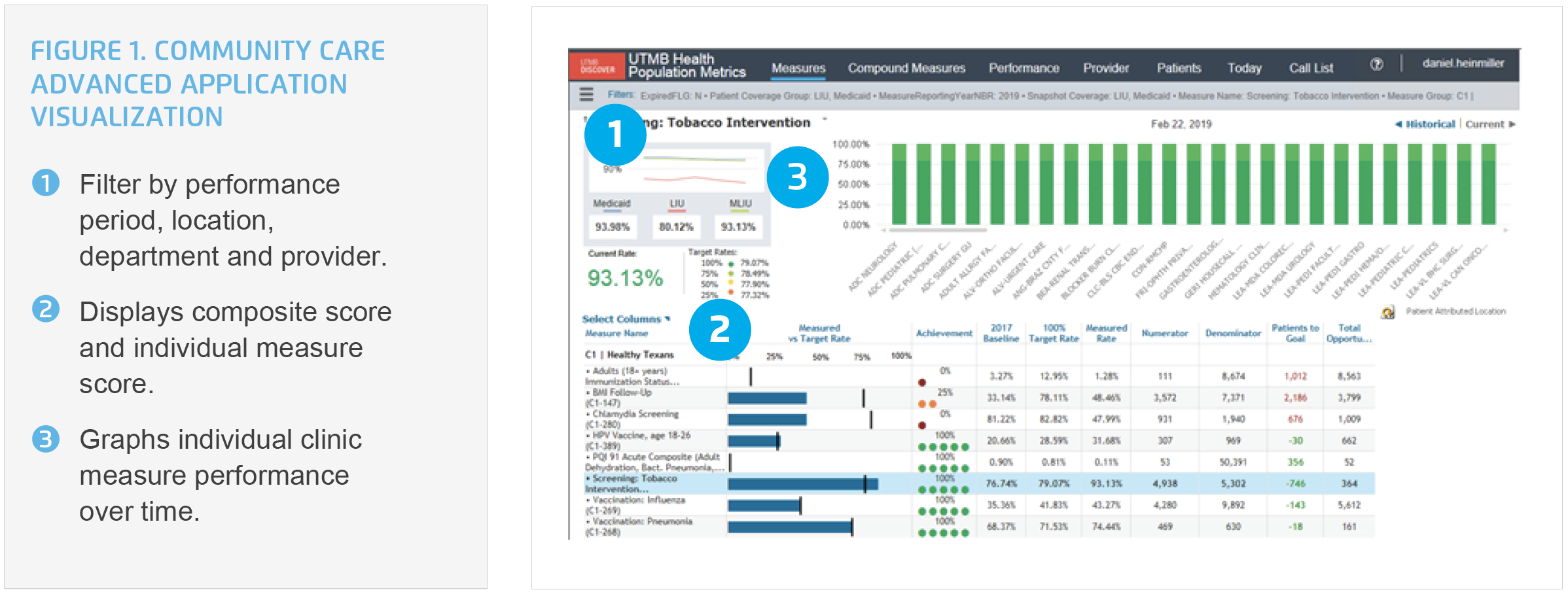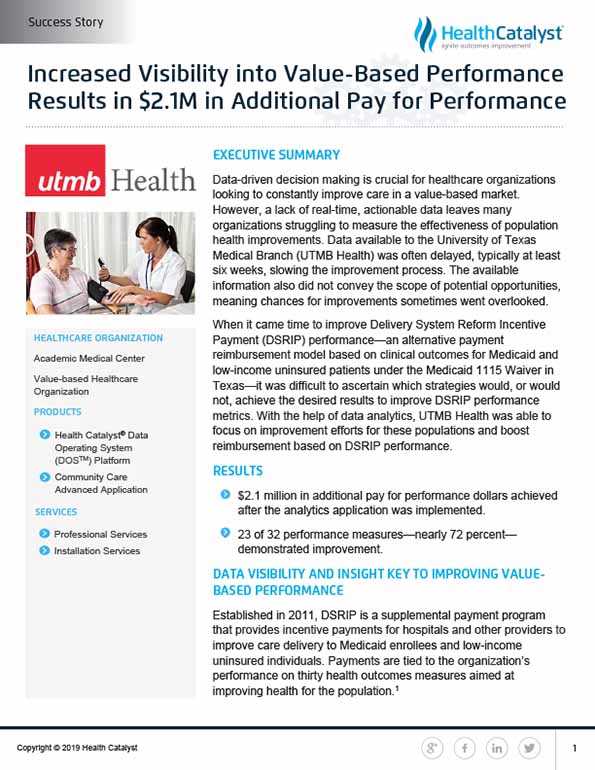Data-driven decisions and analytics are critical for organizations and physician practices attempting to thrive under value-based care. With the help of data analytics, UTMB Health was able to focus on improvement efforts for specific patient populations and boost reimbursement based on DSRIP performance.
Data-driven decision making is crucial for healthcare organizations looking to constantly improve care in a value-based market. However, a lack of real-time, actionable data leaves many organizations struggling to measure the effectiveness of population health improvements. Data available to the University of Texas Medical Branch (UTMB Health) was often delayed, typically at least six weeks, slowing the improvement process. The available information also did not convey the scope of potential opportunities, meaning chances for improvements sometimes went overlooked.
When it came time to improve Delivery System Reform Incentive Payment (DSRIP) performance—an alternative payment reimbursement model based on clinical outcomes for Medicaid and low-income uninsured patients under the Medicaid 1115 Waiver in Texas—it was difficult to ascertain which strategies would, or would not, achieve the desired results to improve DSRIP performance metrics. With the help of data analytics, UTMB Health was able to focus on improvement efforts for these populations and boost reimbursement based on DSRIP performance.
Established in 2011, DSRIP is a supplemental payment program that provides incentive payments for hospitals and other providers to improve care delivery to Medicaid enrollees and low-income uninsured individuals. Payments are tied to the organization’s performance on thirty health outcomes measures aimed at improving health for the population.1
The Texas DSRIP program coordinated care delivery system is supported through 20 regional healthcare partnerships (RHPs) covering the 254 counties in Texas.2 Healthcare produces massive quantities of data from multiple sources. To make informed decisions for designing improvement efforts to impact care, save lives, and lower costs, organizations must have actionable data.3
While data-driven decision making is critical for organizations and physician practices attempting to thrive in a value-based care market, many organizations struggle with measuring the effectiveness of population health initiatives.4 Improving data analytics is crucial for healthcare organizations who want to remain competitive.
For more than 125 years, UTMB Health has stood with Texas—training the healthcare workforce; helping make the state a leader in advancing the understanding and treatment of illness and injury; serving as a major provider of healthcare for Texans and their families; innovating the future of how care is delivered. The Waiver Operations Team at UTMB Health is responsible for directing daily operations of UTMB Health’s Medicaid Waiver, including serving as the DSRIP anchor institution for Region 2, which includes 16 counties in east and southeast Texas covering over 14,000 square miles. UTMB Health turned to its data for opportunities to improve care delivery to its Medicaid and low-income populations, improving value-based performance reimbursement efforts.
UTMB Health has participated in DSRIP since 2011; however, limited visibility into performance data negatively impacted its ability to effectively target interventions to continuously improve population performance measures. Previously, the data available to UTMB Health was delayed, typically by at least six weeks and when the data was made available, it lacked the level of granularity necessary to drive improvement. The available data also did not convey the scope of potential opportunities, leaving potential avenues for improvement unexplored.
It was difficult for leadership at UTMB Health to ascertain which strategies would, or would not, achieve the desired results to improve DSRIP performance. To effectively drive efforts to improve DSRIP performance, UTMB Health needed timely, actionable data. Without it, insight into opportunities for improvement, and the ability to continuously improve would be impaired.
To improve its insight into performance, UTMB Health partnered with Health Catalyst, implementing the Health Catalyst® Data Operating System (DOS™) Platform and the Community Care Advanced Application. DOS combines the features of data warehousing, clinical data repositories, and health information exchanges (HIEs) into a single, common-sense technology platform.
The Community Care Advanced Application supports primary care program leaders, primary care providers and care coordinators working in ambulatory settings, quality improvement teams, and staff responsible for reports related to the organization’s status with performance measures. The analytics application provides UTMB Health access to timely, actionable data to help it review population health, compare its performance to national benchmarking standards for specific measures, and identify opportunities for costs savings. The application helps UTMB Health track, monitor, and meet the needs of high-risk patients (see Figure 1).

The data within the application refreshes daily, allowing the team to review measure performance in near real-time. For the first time, UTMB Health is able to systematically assess performance and identify specific interventions that can be made, including interventions for specific patients, to raise measure performance. With visibility into data, leaders and clinicians are able to manage patient visits for enhanced panel management prospectively. UTMB Health can prioritize patient visits and implement outreach strategies aimed at ensuring patients are seen and receive the appropriate care, improving DSRIP performance by reducing missed appointments and gaps in care.
When patients are scheduled to be seen, UTMB Health is better able to identify the specific DSRIP assessments and care each patient needs. For example, a patient with diabetes and English as a second language is scheduled for an appointment. Clinicians and support staff are able to efficiently identify that the patient has good hemoglobin A1c control (HbA1c) but needs better blood pressure control. Additionally, they can immediately tell that this patient is due for their annual foot exam, should receive a mammogram, and needs an influenza vaccination.
Armed with better information about specific patient needs, clinicians and support staff are able to improve pre-visit planning and adequately staff based on expected patient volume. The clinical support team informs the provider of the DSRIP measures/patient care activities that need to be addressed during the visit and ensures appropriate supplies, such as vaccinations or access to an interpreter, are available during the scheduled visit.
By conducting an in-depth review of the data from the analytics application, UTMB Health identified new opportunities to achieve higher levels of DSRIP performance and developed specific, targeted interventions to move measure performance from red to green. For example, performance data in the analytics application illustrated that some patients with diabetes who needed an annual foot exam were not receiving the exam. Further exploration of the data demonstrated that UTMB Health had the opportunity to improve completion of diabetic foot exams for pregnant women with type 1 or type 2 diabetes. The team subsequently developed standard workflows to ensure pregnant women with diabetes received the examination during one of their prenatal appointments, substantially improving annual foot exam measure performance.
Data in the analytics application also assisted UTMB Health in efficiently identifying gaps in breast cancer screening documentation. While patients were receiving the appropriate breast cancer screening, scanned documents and lack of standard workflow for documentation in the EMR resulted in some patients not being captured in the numerator for the performance measure. By standardizing workflows and providing ongoing feedback to clinicians, UTMB Health has improved data integrity and has made substantial improvements in accurate reporting for breast cancer screening measure compliance.
Recently, UTMB Health was able to leverage the analytics platform to generate a list of 600 patients who were missing a valid HbA1C lab test in the UTMB Health system; this near real-time data allowed for focused efforts to determine what cross-walk opportunities existed with the HIE to ensure appropriate capture of external results—important information for both DSRIP performance reporting and effective management of patients with diabetes/pre-diabetes.
In addition to these specific examples, having access to validated, actionable data has helped UTMB Health engage providers in implementing standard clinic workflows and documentation processes. Providers are given timely, ongoing feedback on their individual measure performance, leading to better engagement and improved adoption of standard workflows. Similarly, having access to timely, actionable data allows UTMB Health to more effectively prioritize resource allocation for improvement and supports UTMB Health in breaking down silos, ensuring standard work is occurring across multiple clinic locations. The accessibility and wealth of data have proven to be invaluable in ensuring UTMB Health can meet or exceed annual DSRIP targets.
With its new analytics-driven insight into opportunities for improvement and more effective prioritization of resources, UTMB Health has realized substantial results, including:
“Previously, we would need to submit a request for a new report, and it would often be up to six weeks before we received the data we needed. Now, through the analytics platform, we have near real-time data. This has dramatically improved our ability to use data to drive improvement.”
– Susan Seidensticker, MSHAI, CPHQ, CSSBB, PMP, Director, Waiver Quality Operations, University of Texas
UTMB Health plans to continue its analytics-driven approach to improving care for Medicaid and low-income uninsured individuals. UTMB Health intends to use data to inform the prioritization of further improvement efforts, such as mailing colorectal screening supplies to individuals with transportation barriers.
The health system also plans to further improve efficiency by implementing closed-loop analytics, enabling immediate action based upon the data from the analytics application while reducing the number of clicks required to effectively document patient care.


